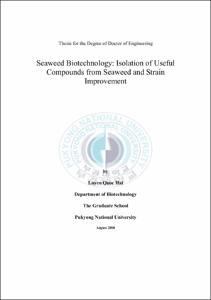Seaweed Biotechnology: Isolation of Useful Compounds from Seaweed and Strain Improvement
- Alternative Title
- 해조 생물공학: 해조류로부터 유용물질의 분리 및 품종개량
- Abstract
- Seaweed biotechnology is a multidisciplinary subject to produce food, pharmaceuticals, chemicals, and environmental remediation materials from seaweed resources. For centuries, seaweed has been of botanical, industrial and pharmaceutical interest. Compounds extracted from the seaweed are important in pharmaceutical industries. In particular, our survey effort in this area have led to two main themes in studies: (1) screening, isolation and biological analysis of biologically active substances, such as microalgal growth enhancer, antifouling agent and anti-inflammatory (2) tissue culture and mutant selection to overcome supply issues of useful substances. These studies are highly interdisciplinary in nature and draw on diverse methodologies in marine biotechnology. Firstly, in an attempt to identify the microalgal growth enhancer, we isolated the compound levoglucosan from the green seaweed Monostroma nitidum, which enhances cell growth in several microalgae in various culture media. Yield of the compound from seaweed powder was 5 × 10-3% (w/w). At 10 mM concentration, levoglucosan enhanced cell growth and the specific growth rate of all feed microalgal species tested (Chaetoceros gracilis, Chlorella ellipsoidea, Dunaliella salina, Isochrysis galbana, Nannochloris oculata, Navicula incerta, Pavlova lutheri, Tetraselmis suecica) in most culture media by approximately 150%. Cellular fatty acid profiles and cell size differed marginally between cultures with and without levoglucosan. Secondly, during our studies on allelopathic compounds as environmentally friendly antifouling agents led to the isolation of a novel fatty acid, heptadeca-5,8,11-trienoic acid (HDTA: C17:3). HDTA, an odd-numbered carbon atom fatty acid, showed more than 50% lysis at a concentration of 5 μg/mL against the spores of three chlorophyte species, eight rhodophytes, two phaeophytes, and the cells of three phytoplanktons. Lysis activity increased as the number of double bonds and carbon atoms in the fatty acid increased. HDTA showed ten-fold stronger activity with LC50 of 3.1 μg/mL than α-linolenic acid (C18:3). Thirdly, we summarize our study on the anti-inflammatory effects of C. fragile involving isolation and structure determination of active substances. The main active compound was isolated by acetonitrile extraction, fractionating by polarity, silica gel column chromatography, and reverse-phase HPLC to give pure compounds CF-2, CF-6 and CF-7. The structure of compound CF-2 was identified by 1D and 2D of 1H and 13C NMR spectroscopy and GC-MS data and suggested as eicosa-5,8,11,14,17- pentaenoic acid (EPA) (C20:5 ω-3). The structure of compound CF-6 and CF-7 were also studied by the NMR and MS experiments and its structures will be constructed. Purified compounds of EPA, CF-6 and CF-7 were tested for anti-inflammatory activities against the PMA-induced mouse ear inflammation symptoms of edema and erythema. The inhibitory effects of different concentrations of EPA, CF-6 and CF-7 topically applied to mouse ears were dose-dependent. The EPA concentrations producing IC50 were 230 and 462 μg per ear for edema and erythema, respectively. Finally, a strain improvement program was initiated based on mutagenesis with the goal of increasing the content of tryptophan and lysine (essential amino acids) of Porphyra. Three rounds of ultraviolet radiation and selected mutagenic agents (DL-5-methyltryptophan and aminoethyl-L-cysteine) were conducted using monospores of Porphyra as the parent strain. When analyzing the IC100 of selected monospores of the first stage, value of 8 mM and 116 mM, which is higher than original stage, were obtained for DL-5-methyltryptophan and aminoethyl-L-cysteine, respectively. When analyzing the IC100 of selected monospores of the final stage, value of 9.3 mM and 135 mM were obtained for DL-5-methyltryptophan and aminoethyl-L-cysteine, respectively. Our results appear promising that it is possible to increase the volumetric productivity of both essential amino acids using this method
- Issued Date
- 2008
- Awarded Date
- 2008. 8
- Type
- Dissertation
- Keyword
- algal growth enhancer levoglucosan microalgal growth Monostroma nitidum allelopathy crustose coralline algae Lithophyllum spp. anti-inflammatory Codium fragile monospore Porphyra sp. essential amino acids tryptophan lysine strain improvement
- Publisher
- 부경대학교 대학원
- Affiliation
- 부경대학교 대학원
- Department
- 대학원 생물공학과
- Table Of Contents
- List of Figures = iii
List of Tables = v
Abstract = vi
Chapter 1 Seaweed Biotechnology : A Review = 1
Chapter 2 Microalgal growth enhancement by levoglucosan isolated = 31
Abstract = 31
Introduction = 32
Materials and methods = 33
Results = 36
Discussion = 38
References = 40
Chapter 3 Isolation and structure determination of allelopathic compounds = 46
Abstract = 46
Introduction = 47
Materials and methods = 48
Results = 51
Discussion = 54
References = 56
Chapter 4 Anti-inflammatory activity of polyunsaturated fatty acids derived = 68
Abstract = 68
Introduction = 69
Materials and methods = 70
Results = 74
References = 76
Chapter 5 Increase of the yields of L-lysine and tryptophan amino acids = 85
Abstract = 85
Introduction = 86
Materials and methods = 89
Results and discussion = 92
References = 96
국문요약 = 107
Acknowledgement = 109
- Degree
- Doctor
- Files in This Item:
-
-
Download
 Seaweed Biotechnology: Isolation of Useful Compounds from Seaweed and Strain Improvement.pdf
기타 데이터 / 4.41 MB / Adobe PDF
Seaweed Biotechnology: Isolation of Useful Compounds from Seaweed and Strain Improvement.pdf
기타 데이터 / 4.41 MB / Adobe PDF
-
Items in Repository are protected by copyright, with all rights reserved, unless otherwise indicated.